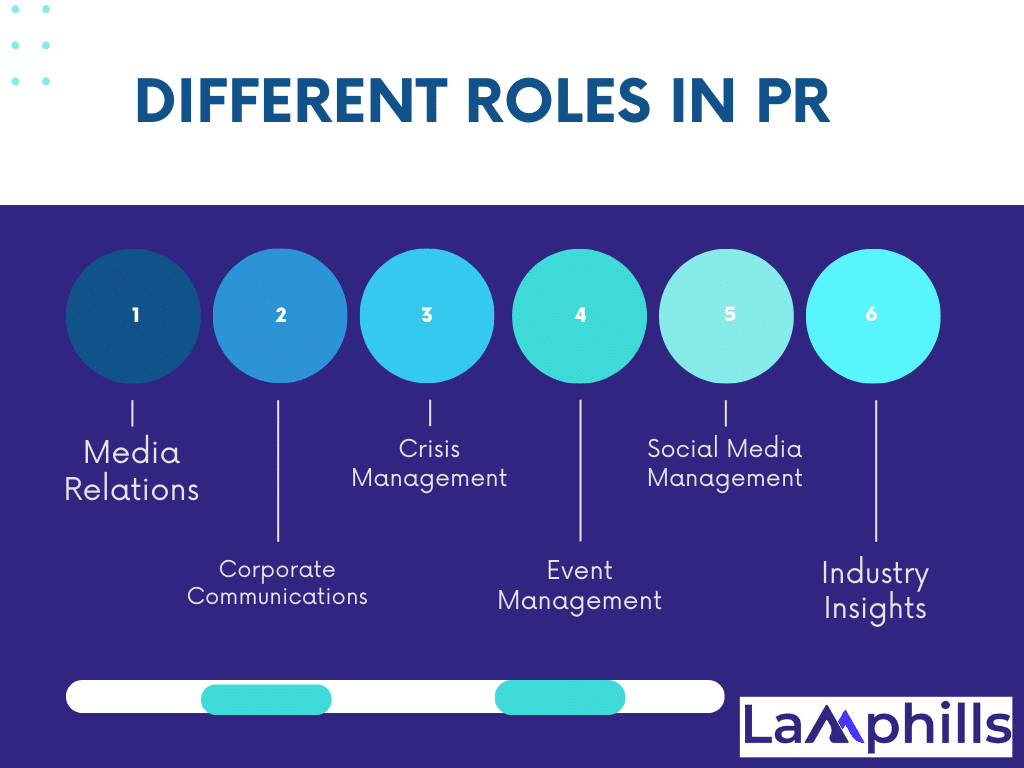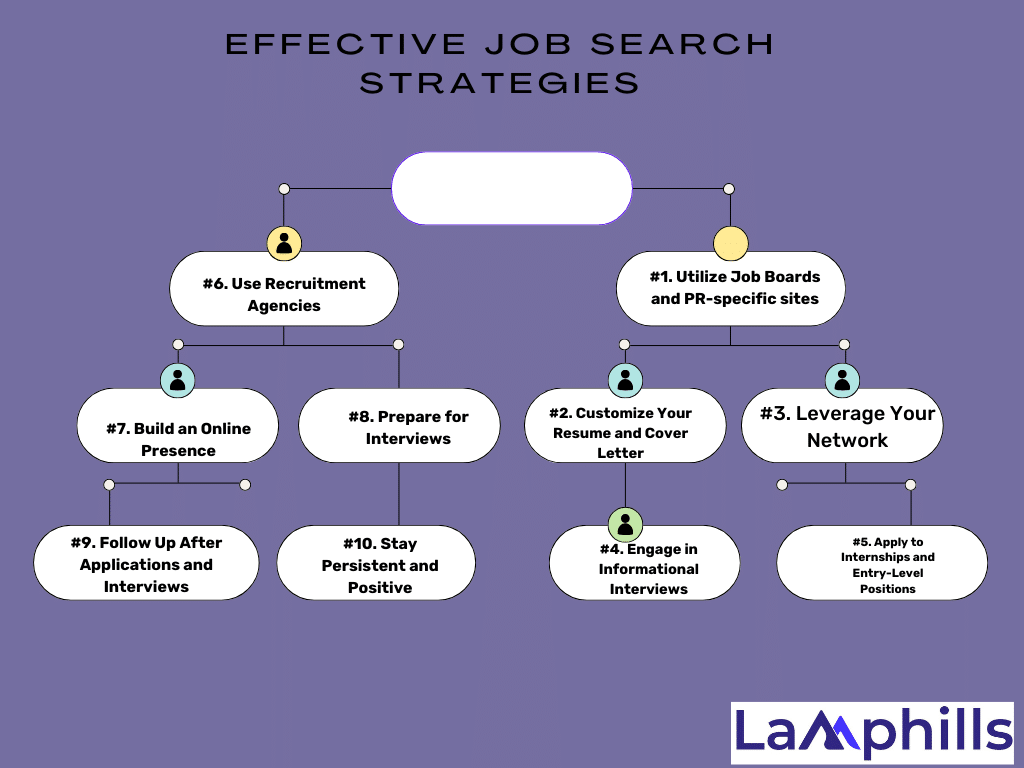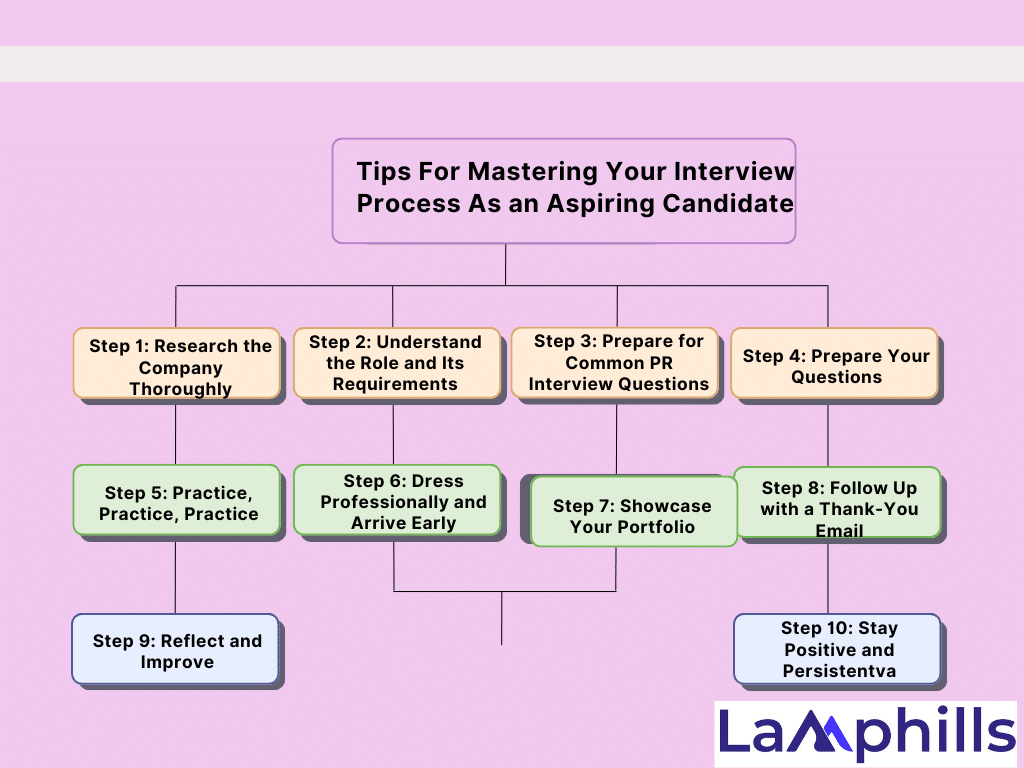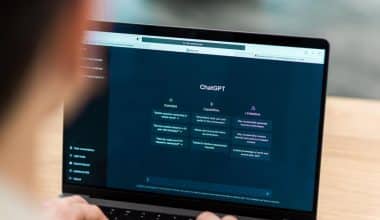I must say, from all indications that public relations experts are the driving force behind well-known organizations. Through social media, media attention, and press correspondence, these specialists assist their customers in projecting a positive public image. They usually do a lot of background work to build a strong public-client or organizational relationship.
I can still feel the excitement and fear from my first PR job search. Eventually, after I have carefully passed the step-by-step process of becoming a certified PR specialist. As a result, my journey from aspiring to being hired was filled with valuable lessons, and I’m here to share those insights with you aspiring to land a career in PR. Read on to learn.
Key Takeaways
- Public relations experts are frequently entry-level personnel in public relations organizations and agencies. They communicate via speeches, press releases, and social media campaigns.
- Public relations experts are the driving force behind your favorite celebrity or well-known organization.
- Different Roles in PR are media relations, corporate communication, crisis, event and social media management, industry insight, etc
- Gaining experience through internships, entry-level positions, and hands-on projects is essential. These roles help build your resume and provide real-world skills that are highly valued by employers.
- To land your first job in PR you must have an educational background, certifications, skills, resume with relevant experiences.
- Tips like dressing professionally, arriving early, and presenting a well-organized portfolio during interviews. Following up with a thank-you email post-interview shows professionalism and reinforces your interest in the role.
What Is a Public Relations Specialist?
Public relations experts are frequently entry-level personnel in public relations organizations and agencies. They communicate via speeches, press releases, and social media campaigns. Their daily activities include responding to media requests, scheduling interviews, writing press releases, producing speeches, and tracking public opinion via social media platforms. These individuals often work conventional work weeks in offices, but they may need to travel to attend press briefings or speeches.
I must tell you that, PR is fundamentally about managing communication between a business and its different audiences—customers, employees, investors, the media, and the general public. Hence, the idea is to project a positive image and establish a strong rapport with these audiences. Now, for you aspiring to become one, know that public relations is the bridge that connects a corporation to the outside world, ensuring that the communications transmitted are clear, consistent, and beneficial.
Landing Your First PR Job: Different Roles in PR

One of the most exciting aspects of PR is the diversity of roles within the field. Here’s a closer look at some of the key areas:
#1. Media Relations
This is collaborating directly with journalists and media sources to gain coverage for your organization. My first media pitch was nerve-wracking but exhilarating. This is because I had to create an engaging story about a new product launch and persuade a reporter that it was newsworthy. In the end, when the story was published, it was a major success and a significant boost to our campaign.
#2: Corporate Communications
This function is responsible for handling the company’s internal and external communications, it entails composing speeches for executives, drafting business-wide communications, and overseeing the company newsletter.
#3. Crisis Management
Handling a crisis is one of the most difficult and important areas of PR. Why is that? This is because it is about responding quickly and efficiently to any incidents that may jeopardize the company’s reputation.
#4. Event Management
Organizing events is another important aspect of PR. This could range from a product launch to a charitable function. I’ll never forget the first big event I organized: a press conference for a technology business. Although, coordinating every detail, from distributing press, and invitations to setting up the venue and ensuring everything ran smoothly, was a huge task, however, seeing the successful coverage and positive feedback made it all worth it.
#5. Social Media Management
Managing a company’s social media presence is critical in today’s digital world. This is because it entails providing content, interacting with followers, and monitoring social media outlets for both favorable and negative comments.
#6: Industry Insights
Understanding current trends and the value of public relations in various industries will help you chart your career path. For example, in the technology industry, public relations experts frequently concentrate on product introductions and innovation stories. In healthcare, public relations is critical for sharing research achievements and managing sensitive information. Each industry presents unique public relations difficulties and opportunities.
PR is likewise adjusting to the digital era. Traditional press releases and media pitches remain important, but digital public relations methods such as influencer collaborations and content marketing are gaining traction. Hence, staying current with these trends and constantly learning is critical to success in public relations.
Landing Your First PR Job: Step-by-step Guide

If you want to work in public relations, know that this innovative and interesting position entails managing a client’s public image. However, understanding the steps involved in becoming a public relations professional will certainly help you begin your job hunt successfully.
#1. Educational Background

The first step toward becoming a public relations specialist is to complete a bachelor’s degree in public relations or a similar field such as communications, business, social science, or journalism.
That is to say, public relations degree programs typically require four years or eight semesters of full-time study to finish. Most bachelor’s degrees, regardless of area, need around 120 hours of coursework, which includes 60 credits of general education and another 60 credits of major-specific courses.
This is because public relations is a job that demands a combination of academic knowledge and practical abilities, and laying that groundwork was an important part of my journey from aspiring to being hired.
#2. Certifications

In addition to a degree, certifications can provide you with a competitive advantage. This is why Accredited in Public Relations (APR) is one of the most widely recognized PR qualifications. This is because it will not only improve your understanding of PR principles but also increase your credibility with employers and clients.
Other credentials, such as Google or HubSpot’s Digital Marketing Certification, are quite valuable given the digital change in public relations. I must confess, that these qualifications helped me understand the complexities of digital campaigns and social media management, giving me more flexibility in my position.
#3. Essential Skills
While formal education and certifications are important, the skill set you develop is what truly sets you apart in PR. Here are some of the key skills that I found crucial:
a. Communication Skills
Effective communication is the cornerstone of public relations. Whether you’re drafting a press release, pitching a story to a journalist, or creating a social media post, your message must be clear and persuasive. I discovered this firsthand while interning at a public relations firm. My supervisor frequently highlighted the significance of succinct and appealing writing.
B. Writing skills
Public relations is fundamentally a writing profession. From press releases and speeches to blog entries and social media content, good writing skills are required. I improved my writing skills through consistent practice and criticism. One memorable project was writing a series of blog posts for a non-profit organization. Each post had to be engaging, informative, and aligned with the organization’s mission. In the end, seeing those posts drive engagement and donations was incredibly rewarding.
C. Strategic Thinking
Public relations is more than just receiving media coverage; it is also about matching your communication efforts with your organization’s overall aims. This demands strategic thought. I recall working on a public relations campaign for a product launch and having to ensure that our messaging was consistent with the company’s broader marketing plan. It took a lot of ideation and planning, but the campaign’s success demonstrated the power of effective public relations.
D. Social Media Expertise
In today’s digital era, being adept at social media is a must. I spent a lot of time studying numerous platforms, including how to engage people, develop great content, and track trends. One of my favorite tasks was running a social media campaign for a small business. We created a hashtag challenge that went viral, boosting the brand’s visibility and engagement significantly.
E. Research and Analytics
Understanding your audience and measuring the effectiveness of your efforts is critical. During my internships, I learned how to use Google Analytics and social media analytics to monitor campaign performance. This analytical approach assisted me in refining my tactics and demonstrating the benefits of public relations efforts to stakeholders.
F. Continuous Learning
Continuous learning is essential in the public relations sector because it is constantly growing. I constantly attend workshops, webinars, and professional conferences to keep up with the latest trends and tools. Joining professional organizations such as the Public Relations Society of America (PRSA) has also been advantageous. PRSA has provided me with opportunities to network with experienced professionals, attend instructive events, and gain access to invaluable tools.
Looking back, I understand that my school background and talents helped me land my first PR position. But aside from technical abilities, what truly made a difference was my willingness to learn and adapt. PR is a dynamic field, and those who prosper seek education and welcome new challenges.
It can be overwhelming to begin this road but keep in mind that every professional started where you are today. However, by laying a solid educational foundation and polishing the necessary abilities, you’ll be well-prepared to move from aspiring to being hired in the fascinating field of public relations.
#4. Building Your Resume and Portfolio

Creating a solid resume and portfolio is an important step toward securing your first job in public relations (PR). When I first started, I realized that having a well-crafted résumé and an appealing portfolio may make all the difference. Here’s a step-by-step instruction based on my experience and what I’ve learned so far.
Step 1: Crafting Your Resume
Your resume is often the first impression a potential employer will have of you, so it’s essential to make it count.
- Start with a Strong Header
Include your name, contact information, and LinkedIn profile. Make sure your email address is professional.
- Write a Compelling Summary
This should be a brief paragraph at the top of your resume that highlights your key skills and experiences. For example, “Aspiring PR professional with a degree in Communications and hands-on experience in media relations and social media management. Skilled in crafting compelling messages and managing successful campaigns.”
- Detail Your Education
List your degrees, the institutions you attended, and your graduation dates. Include any relevant coursework or projects. If you had a standout project, like creating a PR campaign for a class, mention it here.
- Highlight Your Experience
Start with your most recent job or internship. Use bullet points to describe your responsibilities and achievements. Focus on quantifiable results, such as “Increased social media engagement by 30% through targeted content strategies” or “Secured media coverage in major outlets, resulting in a 50% increase in brand visibility.”
- Showcase Your Skills
Include a section for key skills, such as media relations, press release writing, event planning, social media management, and analytics. Tailor this section to match the job description of the position you’re applying for.
- Add Certifications and Professional Development
If you have certifications like APR or completed relevant courses, list them here. This demonstrates your commitment to continuous learning.
Step 2: Developing Your Portfolio
A strong portfolio showcases your best work and demonstrates your capabilities to potential employers.
- Collect Your Best Work
Gather samples of your work, such as press releases, articles, social media posts, campaign summaries, and case studies. During my first internship, I wrote a press release for a product launch that was picked up by several media outlets. Including this in my portfolio helped demonstrate my writing skills and media relations success.
- Organize Your Portfolio
Create sections for different types of work. For example, have separate sections for writing samples, social media campaigns, and case studies. This makes it easy for employers to find what they’re looking for.
- Create a Digital Version
In today’s digital age, having an online portfolio is essential. Use platforms like LinkedIn, a personal website, or portfolio-specific sites like Behance to showcase your work. Make sure it’s easy to navigate and visually appealing.
- Include Context and Results
For each piece of work, provide a brief description of the project, your role, and the results achieved. For instance, if you organized an event, mention the goals, your responsibilities, and the outcome, such as attendee numbers or media coverage.
- Update Regularly
Keep your portfolio up-to-date with your latest work. Every new project or achievement should be added to showcase your ongoing development and success.
Step 3: Tailoring Your Application
When applying for specific jobs, it’s crucial to tailor your resume and portfolio to match the job description.
- Analyze the Job Description
Identify the key skills and experiences the employer is looking for. Highlight these in your resume and portfolio. If a job emphasizes media relations, make sure your relevant experiences and samples are prominent.
- Customize Your Summary and Skills
Adjust your resume summary and skills section to align with the job. Mention specific skills or experiences that are listed in the job posting.
- Select Relevant Samples
Tailor your portfolio by selecting samples that are most relevant to the job. If applying for a social media manager role, prioritize your social media campaigns and content creation work.
Step 4: Seeking Feedback
Before sending out your resume and portfolio, get feedback from mentors, colleagues, or career services.
- Ask for Reviews
Request detailed feedback on both content and format. I found it incredibly helpful to have my resume reviewed by a mentor who had extensive experience in PR. Their insights helped me refine my resume and highlight my strengths more effectively.
- Make Necessary Revisions
Use the feedback to make improvements. Sometimes a fresh perspective can reveal areas for enhancement that you might have missed.
Step 5: Final Checks
Ensure everything is polished and professional before submitting your application.
- Proofread
Double-check for any typos or grammatical errors. A single mistake can make a bad impression.
- Format Consistently
Ensure your resume is easy to read, with consistent formatting and fonts. Your portfolio should be visually appealing and well-organized.
- Prepare Digital Versions
In addition, have PDFs of your résumé and portfolio ready to email. Make sure your online portfolio links are active and accessible.
Creating a solid CV and portfolio requires time and work, but it is a worthwhile investment.
Finally, remember that your resume and portfolio are marketing tools; make them compelling, professional, and representative of your greatest work. Best of luck on your journey from aspiring to recruited!
#5. Gaining Relevant Experience

Experience is frequently a catch-22: you need it to land a job, but you also need a job to earn experience. I began with internships, which gave me practical experience and networking opportunities. Volunteering for non-profits also allowed me to expand my portfolio and get practical experience.
Also, freelancing was an excellent way to get experience. I worked on minor assignments like producing press releases for local firms. Networking was also very important. I joined public relations associations, attended industry events, and networked with professionals on LinkedIn. These contacts frequently led to career opportunities and good advice.
You can also make reference to the detailed checklist below anytime,
Landing Your First PR Job: Effective Job Search Strategies

Searching for your first job in public relations (PR) may be both thrilling and intimidating. I remember vividly the mix of excitement and fear I felt as I began my job hunt. Over time, I learned numerous tactics that greatly increased my odds of finding a job. Here, I’ll share those tactics with you, along with personal experiences and practical advice to aid you on your journey from aspiring to hired.
#1. Utilize Job Boards and PR-specific sites
Employment boards are an excellent place to start your employment hunt. Indeed, LinkedIn, and Glassdoor all provide thousands of job postings in a variety of industries. However, specialty employment forums such as PRSA Jobcenter, MediaBistro, and Communications Jobs may provide more tailored chances for PR positions.
During my job search, I discovered an internship with a prominent public relations business through PRSA Jobcenter. This internship proved to be a stepping stone, giving me crucial professional experience and connections.
#2. Customize Your Resume and Cover Letter
If you’re applying for a media relations role, highlight your expertise in preparing press releases, pitching journalists, and securing media attention. Make your application stand out by including keywords from the job description.
Each job application should be tailored to match the specific role and company you’re applying to. This means customizing your resume and cover letter to highlight relevant skills and experiences.
#3. Leverage Your Network
Networking is an extremely effective technique in any job hunt. To do this, connect with PR professionals on LinkedIn, attend industry events, and join professional organizations such as the Public Relations Society of America (PRSA).
Early in my career, I visited a PRSA conference and met a senior public relations officer. We remained in touch, and a few months later, she told me about a job opening at her company. Networking resulted in a direct referral, and eventually, a job offer.
#4. Engage in Informational Interviews
Informational interviews are a great way to learn about the PR field and make connections without the pressure of a formal job interview. So, reach out to professionals in roles you’re interested in and request a brief meeting to discuss their career paths and advice.
#5. Apply to Internships and Entry-Level Positions
Starting with an internship or entry-level position can provide invaluable experience and help you build a strong foundation in PR. These roles often lead to full-time opportunities within the same organization.
#6. Use Recruitment Agencies
Recruitment agencies can be particularly helpful for specialized fields like PR. These agencies have connections with numerous companies and can help match you with roles that fit your skills and experience.
#7. Build an Online Presence
Having a professional online presence is essential in today’s digital age. Ensure your LinkedIn profile is up-to-date with your latest experiences and skills. Consider creating an online portfolio to showcase your work.
I created a personal website to showcase my portfolio, including writing samples, press releases, and case studies. This made it easy for potential employers to see my work and demonstrated my digital savvy. Several interviewers mentioned they were impressed by the professionalism of my online portfolio.
#8. Prepare for Interviews
Preparation is key to acing job interviews. Research the company, practice common PR interview questions, and prepare examples of your past work and accomplishments.
#9. Follow Up After Applications and Interviews
After submitting a job application or completing an interview, always follow up with a thank-you email. This shows your appreciation and keeps you top of the mind for the employer.
#10. Stay Persistent and Positive
I faced several rejections before landing my first full-time PR job. Each rejection was disheartening, but I used them as learning experiences to improve my resume, interview skills, and job search strategies. In the end, persistence paid off when I finally received an offer for a role that was a perfect fit for my skills and career goals.
This is because Job searching can be a long and challenging process. Hence, It’s important to stay persistent, keep applying, and maintain a positive attitude, even in the face of rejection. Finally, remember, the journey from aspiring to being hired may have its challenges, but with dedication and the right approach, you’ll be well on your way to a successful career in public relations.
Landing Your First PR Job: Tips For Mastering Your Interview Process As an Aspiring Candidate

Mastering the interview process is the final and most important step in obtaining your first job in public relations (PR). I remember how nerve-racking it was to prepare for my first PR interview, but with the appropriate attitude, you can get through this step calmly and successfully. Here’s a step-by-step strategy to successfully pass your public relations interviews.
Step 1: Research the Company Thoroughly
Before your interview, it’s essential to research the company extensively. Understanding the company’s mission, values, recent projects, and the PR team’s role within the organization will help you tailor your responses and show that you’re genuinely interested.
Step 2: Understand the Role and Its Requirements
Carefully review the job description to understand the skills and experiences the employer is looking for. Identify the key responsibilities and think about how your background aligns with them.
Example: If the role emphasizes media relations, prepare to discuss your experience with pitching stories and building relationships with journalists.
Step 3: Prepare for Common PR Interview Questions
Several questions are frequently asked in PR interviews. Preparing thoughtful responses to these questions can give you a significant advantage. For instance,
a. “Tell me about yourself.”
This is your chance to give a concise summary of your background, focusing on your education, relevant experiences, and why you’re passionate about PR.
- My Approach: “I recently graduated with a degree in Communications and completed internships where I gained hands-on experience in media relations and social media management. I’m passionate about PR because I love crafting compelling stories and building relationships that help organizations succeed.”
B. “Why do you want to work in PR?”
Explain your motivations and what draws you to the field.
- My Approach: “I’m drawn to PR because it combines my love for writing with my interest in strategic communication. I enjoy the challenge of creating impactful messages and seeing how they resonate with different audiences.”
C. “Describe a successful PR campaign you’ve worked on.”
Share specific details about a campaign you were involved in, focusing on your role and the results achieved.
- My Approach: “During my internship, I worked on a campaign to promote a new product. I wrote press releases, coordinated with influencers, and organized a launch event. The campaign resulted in a 40% increase in media coverage and significantly boosted our social media engagement.”
D. “How do you handle criticism or negative feedback?”
Demonstrate your ability to accept feedback and improve your work.
- My Approach: “I view criticism as an opportunity to grow. In one of my internships, a press release I wrote was heavily edited. I reviewed the changes carefully, discussed them with my supervisor, and used the feedback to improve my writing skills.”
E. “How do you stay updated on PR trends and industry news?”
Show your commitment to continuous learning and staying informed about the industry.
- My Approach: “I follow industry blogs, subscribe to PR newsletters, and regularly attend webinars and industry events. I also participate in PRSA forums to exchange ideas and insights with other PR professionals.”
Step 4: Prepare Your Questions
At the end of most interviews, you’ll have the opportunity to ask questions. Prepare thoughtful questions that demonstrate your interest in the role and the company.
Examples:
- “Can you describe the day-to-day responsibilities of this role?”
- “How does the PR team collaborate with other departments?”
- “What are the company’s biggest PR challenges, and how does this role contribute to overcoming them?”
Step 5: Practice, Practice, Practice
Practicing your responses can help you feel more confident and articulate during the interview.
My Experience: I practiced answering common interview questions with a friend who provided feedback. We also conducted mock interviews to simulate the actual interview environment. This practice helped me refine my responses and improve my delivery.
Step 6: Dress Professionally and Arrive Early
First impressions matter, so dress professionally and arrive early for your interview. This shows that you’re serious about the opportunity and respect the interviewer’s time.
Step 7: Showcase Your Portfolio
Bring a well-organized portfolio to the interview, either in print or digital form. This should include your best work, such as press releases, media pitches, campaign summaries, and any other relevant materials.
Step 8: Follow Up with a Thank-You Email
After the interview, send a thank-you email to express your appreciation for the opportunity and reiterate your interest in the role.
Pro tip: I always send a thank-you email within 24 hours of the interview. In the email, I mention specific topics we discussed and highlight why I believe I’m a good fit for the position. This not only shows gratitude but also keeps me fresh in the interviewer’s mind.
Step 9: Reflect and Improve
After each interview, take some time to reflect on what went well and what could be improved. This self-assessment helps you prepare better for future interviews.
My Experience: After each interview, I jot down the questions asked and my responses. I then review these notes to identify areas for improvement. This practice has helped me refine my interview skills over time.
Step 10: Stay Positive and Persistent
The interview process can be challenging, and you may face rejections. Stay positive, learn from each experience, and keep applying.
How can I Earn the APR Credential?
PRSA’s APR credential demonstrates advanced PR and communications skills to employers and colleagues. This optional certification can increase job prospects and earning potential. Read on to find out the steps to gain APR certification.
#1. Work in PR for at Least Five Years
PRSA recommends at least five years of PR experience before taking the APR certification exam. College students or recent graduates can pursue the Certificate of Principles in PR credential while gaining the minimum work experience recommended for the APR certification.
#2. Apply to Take the APR Exam
you are ready, you can fill out the application for the APR exam through PRSA’s website. The exam costs $385 to $410 for Universal Accreditation Board (UAB) members and $745 for non-members.
#3. Sit for a Panel Presentation
PRSA uses a panel presentation to evaluate an APR candidate’s PR knowledge in ways that an exam cannot. The panel presentation tests 12 different areas of public relations knowledge through a questionnaire and presentation, for which candidates prepare a portfolio.
#4. Take the APR Exam
The APR exam itself consists of 132 scored questions. To study for the exam, PRSA offers candidates a free APR study guide or an online APR prep course which costs $195 for PRSA or UAB members and $295 for non-members.
#5. Renew Your Credentials
After earning an APR certification, public relations professionals must renew the credential every three years by completing the required number of continuing education units (CEUs). Required CEUs changes, so check PRSA’s website for the most up-to-date information on renewal.
Can I get a PR job without a degree?
The industry today values a blend of education and practical skills. Many Publicists have indeed forged successful careers with diverse academic backgrounds, and some have climbed the ranks without a degree specifically tailored to the field.
Does PR pay well?
Of course, Public Relations Specialists earned an average salary of $78,540 in 2022.
How competitive is public relations?
Public relations is a highly competitive field and a degree is pretty much a must
Conclusion
Landing your first public relations job is a learning and growing experience. However, understanding the field, developing the necessary abilities, obtaining relevant experience, and mastering the job search process will help you move from aspiring to hired. Remember, persistence and continued development are essential. I hope these insights will aid you on your way in public relations just like it allowed me to improve in my profession and opened me new opportunities.
References
- indeed.com
- forbes.com
- prospects.ac.uk
- bls.gov






